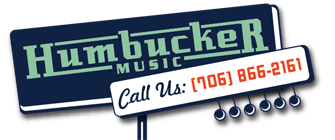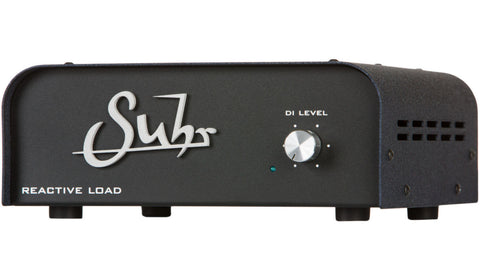Suhr Reactive Load
- DESCRIPTION
The Suhr Reactive Load is a direct recording/performance speaker load that takes the place of your speaker cabinet within your signal path. This device allows you to capture all your guitar, amp, and pedal tone, then send it directly to a recording device, PA system, or even your computer for those late night YouTube recordings. No need to wake the neighbors by miking your speaker cab. Those days are over!
The Suhr Reactive Load provides an 8 ohm load for your tube amplifier up to 100 watts and produces a balanced and unbalanced signal.
You want to use it to record and play live? No problem! The Reactive Load also features a "Thru" output on the back that sends your powered signal to your speaker cab for normal performance.
Wait a second! What the heck does "reactive load" mean? What makes this different than the others?
Great question! As you know, with tube amps your tone is far superior to transistor or solid state amps. Tube circuitry requires a speaker not only to make sound (that part is obvious) but to also provide resistance (also known as a "load") to the output stage of the amp. When you place something in the path between the output stage and a speaker in order to capture the signal, you have to provide some kind of load for the tube amp to create the dynamics and warmth they're known for. Without this load on the amp, they sound sterile and thin. This is why most direct outputs on amps sound like absolute garbage.
Now, with that said, there are a couple different types of loads you can put on a tube amp. There's resistive and reactive. Resistive is what you typically find in the more economical attenuators and cab simulators. They work decently. They provide the necessary load (rated in ohms, e.g. 8Ω) to make the tube amp operate properly. HOWEVER, and this is a big however, they do not mimic a speaker precisely. As a speaker's voice coil moves, it's resistance varies slightly and that does indeed cause a tube amp's circuit to react differently. The tone is a little different with a speaker than it is with a straight, unwavering resistance load. This is where a reactive load comes into play. With a reactive load, the resistance varies in the way a speaker varies, causing the tone and feel to be much more precise. This technology is more expensive to create, thus reactive load attenuators, cab simulators, and DI's are always more expensive. It's one of those "you get what you pay for" moments. You want the best? You'll have to pay a little more for a Reactive Load.
Features:
True Reactive Load
Captures the warmth and dynamics of your guitar sound
Balanced and Unbalanced outputs for recording
Accommodates tube amplifiers (maximum 100 watts)
Specifications:
Input Impedance: 8Ω
DI / Line Out Level: +4 dBu at 7 watts input, maximum level setting
Balanced Line Output Impedance: 10KΩ
Unbalanced Line Output Impedance: 10KΩ
Maximum recommended input power: 100 Watts RMS
Dimensions: 8.8" Width x 8.9" Depth x 3.6" Height
The Suhr Reactive Load provides an 8 ohm load for your tube amplifier up to 100 watts and produces a balanced and unbalanced signal.
You want to use it to record and play live? No problem! The Reactive Load also features a "Thru" output on the back that sends your powered signal to your speaker cab for normal performance.
Wait a second! What the heck does "reactive load" mean? What makes this different than the others?
Great question! As you know, with tube amps your tone is far superior to transistor or solid state amps. Tube circuitry requires a speaker not only to make sound (that part is obvious) but to also provide resistance (also known as a "load") to the output stage of the amp. When you place something in the path between the output stage and a speaker in order to capture the signal, you have to provide some kind of load for the tube amp to create the dynamics and warmth they're known for. Without this load on the amp, they sound sterile and thin. This is why most direct outputs on amps sound like absolute garbage.
Now, with that said, there are a couple different types of loads you can put on a tube amp. There's resistive and reactive. Resistive is what you typically find in the more economical attenuators and cab simulators. They work decently. They provide the necessary load (rated in ohms, e.g. 8Ω) to make the tube amp operate properly. HOWEVER, and this is a big however, they do not mimic a speaker precisely. As a speaker's voice coil moves, it's resistance varies slightly and that does indeed cause a tube amp's circuit to react differently. The tone is a little different with a speaker than it is with a straight, unwavering resistance load. This is where a reactive load comes into play. With a reactive load, the resistance varies in the way a speaker varies, causing the tone and feel to be much more precise. This technology is more expensive to create, thus reactive load attenuators, cab simulators, and DI's are always more expensive. It's one of those "you get what you pay for" moments. You want the best? You'll have to pay a little more for a Reactive Load.
Features:
True Reactive Load
Captures the warmth and dynamics of your guitar sound
Balanced and Unbalanced outputs for recording
Accommodates tube amplifiers (maximum 100 watts)
Specifications:
Input Impedance: 8Ω
DI / Line Out Level: +4 dBu at 7 watts input, maximum level setting
Balanced Line Output Impedance: 10KΩ
Unbalanced Line Output Impedance: 10KΩ
Maximum recommended input power: 100 Watts RMS
Dimensions: 8.8" Width x 8.9" Depth x 3.6" Height












